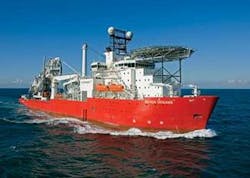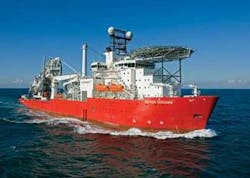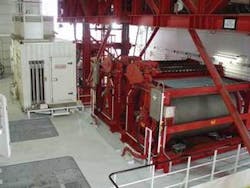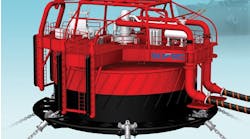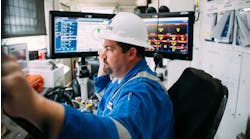Containerized ROV deployment system minimizes noise, vibration
In recent years, Hagglunds Drives has provided Subsea 7 with the motor/brake assemblies for its ROV deployment winches, along with associated power units and controls. Hagglunds has also supplied auxiliary systems to operate A-frame launching equipment.
The company’s two most recent contracts for the subsea contractor were for theSeven Seas, a deepwater pipelay and construction vessel primarily used to install flexible pipelines, and the Seven Oceans, a deepwater rigid pipelay vessel. Both were built at the Merwede shipyard in Rotterdam.
Each vessel features two permanently installed side-launching workclass ROV systems rated to 3,000 m (9,842 ft) water depth. The detailed design specification for these was drawn up by Subsea 7 to include comprehensive design of the starters and controls, based on their long experience of using these systems.
The Lebus winches are driven by Viking 84 series direct drive motors with band brake assemblies, the motors providing high torque (mechanical) efficiency and tension control for deployment of the ROV umbilicals. Hagglunds also supplied the PEC-type power units, starters, and controls, all housed in a soundproofed 20-ft (6.1-m) container. The latter includes a stainless steel, 1,200-l (317-gal) reservoir with seawater cooling system and a full health monitoring system.
Each power unit weighed around 15 metric tons (16.54 tons) and was supplied with a special four-leg sling to take into account the uneven weight distribution inside the container to lift the unit clean and within 5° of horizontal. To enable air paths for cooling of the electric motor both inside and outside of the container, while maintaining the strict noise levels, Hagglunds designed acoustic attenuators for installation on the container’s roof. The company also provided anti-vibration type “feet” for the pump sets and the container base to reduce vibration transmitting from the container to the deck.
One challenge was to design the layout to fit all of the equipment in the container in positions to simplify piping and cabling and to provide easy access for maintenance and troubleshooting. The equipment comprised pump sets, the tank unit, large filters, the sea water cooling system with flow meters, manifold blocks, starter control panels, distribution boards, cabling, lighting, and heating, plus shelves for the manuals and other necessary documentation. There was also a sealed area around the hydraulic components to contain any leakage.
Each power unit comprises two 290 kW electric motors coupled to closed-loop hydraulic transmission pumps for the winches, providing constant tension and wave riding with electronic proportional control for the pressure. This enables the winch to pull in and pay out quickly at a set tension that is controlled to suit the ROV and the conditions. Constant power control is also included, using current feedback from the electric motors to the Hagglunds control system to gain maximum output from the winches for a given ROV load.
The auxiliary systems also employed two 55 kW pump sets using axial piston pumps to operate the A-frame. Having two pumps on each function provides redundancy, as one pump can be isolated while the other can be employed on either winch. The complete system, including container construction, had to comply with Subsea 7’s standards for lifting/load testing, safety, acoustics/noise level, pressure and function testing, and comprehensive documentation requirements.
According to Hagglunds, the hydraulic system provides an extremely flexible and user friendly design protected from the environment with adequate space and lighting for operation and maintenance services.
